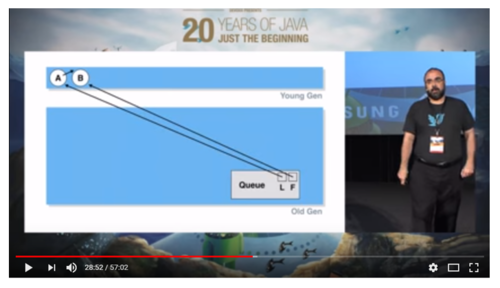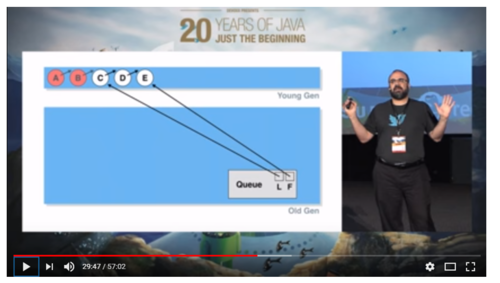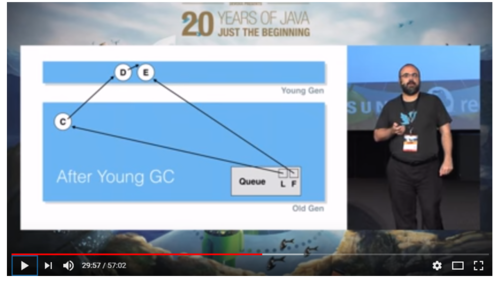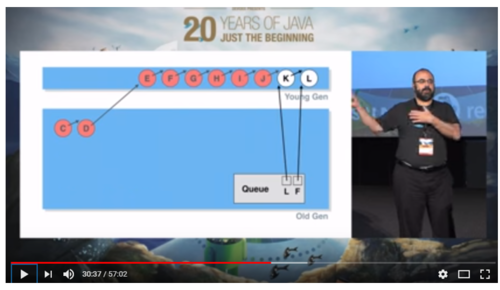本来以为LinkedBlockingQueue的实现应该很简单,就像ArrayBlockingQueue使用一个锁加一个数组一样,使用一个锁加一个单向链表就可以解决了,翻了下jdk8的实现,发现没有这么简单,看了下类开头的一段注释就有点懵逼了,这里复制如下:
/* * A variant of the "two lock queue" algorithm. The putLock gates * entry to put (and offer), and has an associated condition for * waiting puts. Similarly for the takeLock. The "count" field * that they both rely on is maintained as an atomic to avoid * needing to get both locks in most cases. Also, to minimize need * for puts to get takeLock and vice-versa, cascading notifies are * used. When a put notices that it has enabled at least one take, * it signals taker. That taker in turn signals others if more * items have been entered since the signal. And symmetrically for * takes signalling puts. Operations such as remove(Object) and * iterators acquire both locks. * * Visibility between writers and readers is provided as follows: * * Whenever an element is enqueued, the putLock is acquired and * count updated. A subsequent reader guarantees visibility to the * enqueued Node by either acquiring the putLock (via fullyLock) * or by acquiring the takeLock, and then reading n = count.get(); * this gives visibility to the first n items. * * To implement weakly consistent iterators, it appears we need to * keep all Nodes GC-reachable from a predecessor dequeued Node. * That would cause two problems: * - allow a rogue Iterator to cause unbounded memory retention * - cause cross-generational linking of old Nodes to new Nodes if * a Node was tenured while live, which generational GCs have a * hard time dealing with, causing repeated major collections. * However, only non-deleted Nodes need to be reachable from * dequeued Nodes, and reachability does not necessarily have to * be of the kind understood by the GC. We use the trick of * linking a Node that has just been dequeued to itself. Such a * self-link implicitly means to advance to head.next. */
这里涉及到两个问题:
对出队和入队使用两个不同的锁,即putLock和takeLock,为了避免更新元素计数的时候需要同时获取两个锁,这里使用一个
AtomicInteger来计数。这样出队入队可以并发执行,提高性能。到这里还是可以理解的,但是里面又提到为了避免在put的时候需要获取takeLock或者take的时候需要获取putLock,使用了cascading notifies,这玩意还是第一次听到。其实现的
iterator是weakly consistent,即弱一致性迭代器,之前有所耳闻,但是也没有怎么深入去了解,看了下API的描述weakly consistent iterators,倒也挺简单,大概意思是迭代器可以和其他操作并发执行,且不会抛出ConcurrentModificationException,即不是fail-fast的;更重要的是遍历过程中的同步修改不一定会体现出来,比如第一个元素已经遍历过,然后被其他线程删除了,对迭代器来说就不可见了。到这里也还是可以理解的,但是上面的注释又提到了为了提高GC性能,使用了self-link,这也是个新名词。
下面结合代码谈谈自己的理解,如有错误之处望指正!
cascading notifies
Google的一下,一无所获;百度倒是拿到了一个知乎的回答,这是一个跟C++有关的,解释很简单,就是会遗漏notify,造成饥饿,然后给了个链接指向上面LinkedBlockingQueue的代码作为实现的参考。看来这是个冷门知识。还好上面的注释中有更详细的解释:
当一个put操作加入了一个元素,至少可以提供一次take操作的时候,就会signal一个taker,这个taker在做take操作的时候会检查从put操作通知他到到他去take这个过程是否有更多元素进来,有的话会去signal其他taker,然后其他taker有继续signal其他的taker,如此往下,形成级联通知(直译,貌似还挺能表达这个意思)。take操作对puter的通知也是类似的操作。
简单说就是puter自己通知puter,taker自己通知taker,这和传统的producer-consumer模式稍有不同。这里以put操作为例解释下代码:
1 public void put(E e) throws InterruptedException {2 if (e == null) throw new NullPointerException();3 int c = -1;4 Node<E> node = new Node<E>(e);5 final ReentrantLock putLock = this.putLock;6 final AtomicInteger count = this.count;7 putLock.lockInterruptibly();8 try {9 while (count.get() == capacity) {10 notFull.await();11 }12 enqueue(node);13 c = count.getAndIncrement();14 if (c + 1 < capacity)15 notFull.signal();16 } finally {17 putLock.unlock();18 }19 if (c == 0)20 signalNotEmpty();
}21 public E take() throws InterruptedException {22 E x;23 int c = -1;24 final AtomicInteger count = this.count;25 final ReentrantLock takeLock = this.takeLock;26 takeLock.lockInterruptibly();27 try {28 while (count.get() == 0) {29 notEmpty.await();30 }31 x = dequeue();32 c = count.getAndDecrement();33 if (c > 1)34 notEmpty.signal();35 } finally {36 takeLock.unlock();37 }38 if (c == capacity)39 signalNotFull();40 return x;41 } private void signalNotEmpty() { final ReentrantLock takeLock = this.takeLock;
takeLock.lock(); try {
notEmpty.signal();
} finally {
takeLock.unlock();
}
}take函数当没有元素的时候会调用notEmpty.await()阻塞(29#),等待put元素进来,可能会有多个线程在这里阻塞。现在调用put函数,插入一个元素。12#执行入队操作,13#递增计数,返回的是递增前的计数,如果递增前为0,说明之前队列是空的,调用
signalNotEmpty(20#),通知上一步阻塞的线程,但是这里需要获取到takeLock,而且只能唤醒其中一个线程,如果有多个线程其他继续阻塞。take从29#唤醒继续执行,31#执行出队操作,32#递减引用计数,返回递减前的计数,然后判断递减前元素是否大于1,如果有则执行34#,唤醒第一步阻塞的线程。如此扩散下去。这里是是cascading notifies的关键,在take里通知其他taker,由于已经是在takeLock里,不需要重新获取。什么时候会满足33#这个条件呢?考虑这种场景:
put操作执行结束,有个take被唤醒之后31#出队执行完,32#递减计数还没有执行,此时count为1
这时候又put一个元素进来,13#递增计数执行结束,count变为2,此时不满足19#的条件,不会唤醒新的taker
take执行32#的递减,由于count为2,此时满足33#这个条件
由于put持有putLock,take持有takeLock,两者可以并发执行,上面的场景是可能出现的。
到这里cascading notifies的原理应该已经清楚了,那么如果不使用cascading notifies会出现什么情况呢?即上面33#34#不做判断会出现什么情况,继续上面的场景,如果第一步有两个take线程阻塞,第二步唤醒了1个,还有一个在阻塞,这时候因为不执行34#,虽然还有一个元素,但是阻塞的线程却不知道,造成饥饿。如果不使用cascading notifies有什么办法可以避免上面的饥饿出现吗?其实很简单,只要去掉19#判断递增前计数不是0,每次都去唤醒就可以,但是这样每次都要在put中获取takeLock,有一定的性能损耗,设计J.U.C的大神为了提高性能真的是煞费苦心啊!
self-link & weakly consistent
这次百度没找到,Google倒是找到了一条链接Self-linking and Latency + Life of a Twitter jvm enginee,但是要翻墙才能看,大概的内容是实现一个单向链表,如果没有使用self-link则在benchmark的时候gc会STW70s,如果使用了self-link则STW基本可以忽略,但是并没有解释具体的原因,而是给出了一个Yotube视频,是一个Twitter JVM工程师做的分享,里面讲了这个问题。这里截几张图围观下(原谅我渣渣的翻墙网速):
image1
image2
image3
image4
image5
image6
这里其实是涉及到gc的跨代引用,队列已经进入Old Gen(这很正常,队列经常是一个长期对象),新分配的元素是在Young Gen分配:
image中两个新元素A和B入队列,在Young Gen
image2中A和B出队列,新元素C D E入队列,这时候A和B还在Young Gen,在minor gc的时候直接回收掉
image3中C元素进入Old Gen
image4中C元素出队列,但是是在Old Gen,需要Major GC才会回收,而Major GC发生的频率比较低,C会在Old Gen保留比较长时间
image5中D到J都已经出队列,但是由于有Old Gen的C的引用,在minor GC的时候不会回收
image6中D-I全部进入Old Gen
跨代引用造成的后果是大量本应该在Minor GC回收的对象进入Old Gen,在Minor GC的时候需要复制大量的对象,在Major的时候需要回收更多对象,而且还不好并行回收,因此GC压力很大。这里就是开头贴的注释里提到的两个问题:
allow a rogue Iterator to cause unbounded memory retention
cause cross-generational linking of old Nodes to new Nodes if a Node was tenured while live, which generational GCs have a hard time dealing with, causing repeated major collections.
这个问题能不能在GC里解决呢?很难,从上面的过程中可以看到每一步对于GC来说都是很合理的,从GC的角度并没法判断出那些有Old Gen引用的对象是没用的。因此只能在程序中解决。解决的方案其实很简单,而且也经常被使用,只要将出队列的元素的next指向null,比如上面image4中C出队列后指向null,而不是D,这样就消除了跨代引用。
到这里好像问题已经解决了,而且也没有self-link什么事,但是为了实现weakly consistent迭代器,指向null这种方法没法使用。看下LinkedBlockingQueue中迭代器的实现:
static class Node<E> {
E item; /**
* One of:
* - the real successor Node
* - this Node, meaning the successor is head.next
* - null, meaning there is no successor (this is the last node)
*/
Node<E> next;
Node(E x) { item = x; }
}public Iterator<E> iterator() { return new Itr();
}private class Itr implements Iterator<E> {
Itr() { // 获取takeLock和putLock
fullyLock(); try { // 获取第一个节点,如果不为空则获取到节点的值
current = head.next; if (current != null)
currentElement = current.item;
} finally {
fullyUnlock();
}
} public boolean hasNext() { return current != null;
} public E next() {
fullyLock(); try { if (current == null) throw new NoSuchElementException();
E x = currentElement;
lastRet = current;
current = nextNode(current);
currentElement = (current == null) ? null : current.item; return x;
} finally {
fullyUnlock();
}
} private Node<E> nextNode(Node<E> p) { for (;;) {
Node<E> s = p.next; if (s == p) return head.next; if (s == null || s.item != null) return s;
p = s;
}
}
}迭代器是通过一个内部类Itr来实现,构造函数和next函数都需要获取takeLock和putLock,在next函数中会提前设置好current值,hasNext只有判断current是否为空即可。这些都没有特别的地方,关键在nextNode函数的s==p的时候,一个元素的next指向自己,这个时候就返回队列的第一个元素。什么时候会出现这种情况呢?我们看下出队列函数:
private E dequeue() { // assert takeLock.isHeldByCurrentThread();
// assert head.item == null;
Node<E> h = head;
Node<E> first = h.next;
h.next = h; // help GC
head = first;
E x = first.item;
first.item = null; return x;
}其中h.next=h就是让原来的head元素自己指向自己,即self-link,如果没有其他引用指向他就可以GC回收掉,因此一个出队列的元素就会满足上面nextNode中s==p这个条件,也就是在迭代器生成之后,队列有元素出队列了。考虑这种情况:
队列中最开始有A B C D四个元素
这个时候生成迭代器,current指向A,currentElement值为A
迭代还没开始,A B C出队列,且都是
self-link,队列中只剩下D由于A还有current引用,B和C 没有其他引用,这个时候如果GC了B和C可以回收掉
开始迭代,由于current指向A,不为空,且currentElement的值为A,因此A肯定会输出,然后再输出D,这里就体现了
weakly consistent,A已经出队列,但是迭代的时候却还在。
因此一个简单的self-link就解决了上面所说单向链表的跨代GC问题。如果把h.next = h改成h.next = null可以吗?还是考虑上面的情况,在2中current指向A,但是A指向null,3和4都没问题,GC正常;但是5的时候会出问题,current指向A,不为空,且currentElement的值为A,因此A还是会输出;在nextNode(A)函数中Node<E> s = p.next;为null,s==null成立,直接返回null,迭代结束,不会输出D。
总结来说,self-link解决了两个问题:1. GC跨代引用问题 2. 作为已经出队列的元素的标识,这里可以看Node类中的注释,和开头贴的注释的最后一句:self-link含蓄地暗示要跳到head.next。
总结
cascading notifies和self-link可以说是极度冷门的知识,现实中可能用到的机会极少,但是对通过这两个细节我们可以更深入的理解锁和GC的机制,倒也不失一次好机会。这个过程中体会最深刻的地方是JDK的源码真的是一份宝贵的财富,偶尔翻一翻,哪怕看看注释都有可能有新的感悟。
作者:searchworld
链接:https://www.jianshu.com/p/02f5d25f3519
共同学习,写下你的评论
评论加载中...
作者其他优质文章










